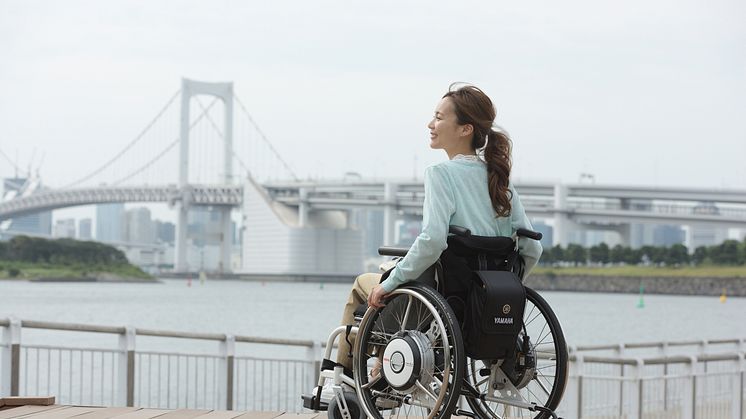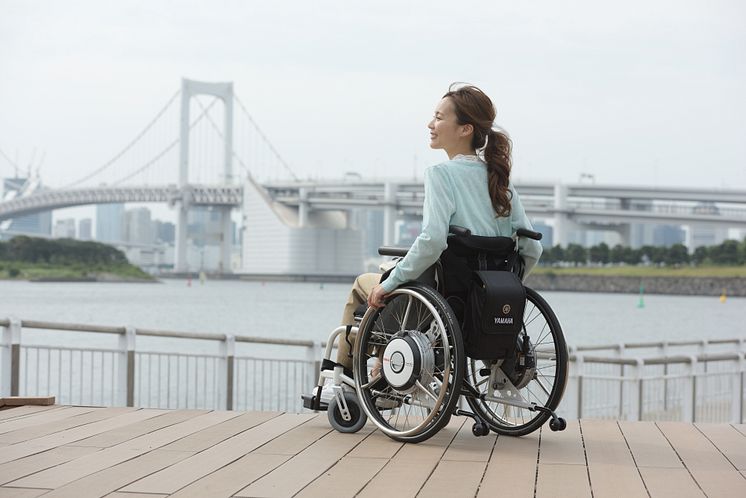
News -
Yamaha’s Electric and Electrically Power-Assisted Wheelchairs Yamaha Motor Monthly Newsletter(Nov.15, 2017 No.59)
Yamaha Motor strives to be a Kando* Creating Company that offers new excitement and a more fulfilling life for people all over the world. To realize this mission, we create products primarily for personal mobility like our motorcycles, scooters and more with a high standard of quality that moves and inspires people, and have expanded our range of customers with a growing line of products.
We also turned our eyes to the wheelchairs that provide daily mobility for the elderly and people with disabilities, and we commercialized a revolutionary electric drive unit that can be after-fitted to a manual wheelchair to turn it into an electric one. Since then, we have always listened to the voices of users to continue improving our wheelchair products, and strive to help them enjoy more comfortable and active lives.
In this issue, we introduce our electric wheelchair business currently aiming to achieve new levels of growth and globalization through a recently launched product utilizing electronic control technologies exclusive to Yamaha.
*Kando is a Japanese word for the simultaneous feelings of deep satisfaction and intense excitement that we experience when we encounter something of exceptional value.
JW Units: To Head Out with More Freedom and Comfort
Wheelchairs can be largely divided into two types: manual ones controlled by the user pushing/pulling on the hand-rims of the main wheels and electric wheelchairs using electric motors to drive the wheels. Electric wheelchairs are typically operated with a joystick or scooter-like handlebars.
Manual wheelchairs have the largest number of users. Since wheelchair users will spend most of their daily lives in their wheelchair, these chairs are specially designed to best fit the individual characteristics and degree of the user’s disability as well as his/her physique so that the chair will be as comfortable, light and easy to move around in as possible. However, once a user heads out into town, there are inclines, steps, curbs and the like scattered around, placing not only great physical strain on the user, but also making longer outings or going for long distances an extremely stressful mental undertaking as well.
Electric wheelchairs greatly reduce the workload and stress of such outings, but the frames mount a power unit and battery, so while durable, they are also very heavy. Many of these wheelchairs have other disadvantages like not being foldable to load into a car easily and being difficult to maneuver in confined spaces. For these reasons, electric wheelchairs were generally regarded as something only for the elderly or people with severe disabilities.
Searching for an answer to this dilemma, Yamaha looked to create a new product that brought together the best qualities of manual and electric wheelchairs. The result was the creation of an electric power unit that could be after-fitted to a manual wheelchair. The unit is composed primarily of two main wheels with electric motors built into the hubs of each, a battery and a joystick controller. With this revolutionary product, users could turn the manual wheelchair they were used to using into an electric one by simply replacing the main wheels with Yamaha’s motorized ones and attaching the battery and joystick.
“For wheelchair users, especially those using manual wheelchairs, the physical demands of getting around and the psychological burden of having to ask others for help can lead to a reluctance to head out altogether,” says one of the developers of the early units. “But we thought that if there was an electric wheelchair that was light and easy to maneuver freely like a manual wheelchair, users would be able to do a lot more things on their own, thus giving them a more positive attitude and helping them enjoy life more in general. That was the kind of product we wanted to create, and it was with that same conviction that we named it ‘JW,’ for ‘Joy Wheel,’” he adds.
After six years of R&D, the JW-I was released in Japan in 1995 as the first JW product. The JW-I got off to a good start thanks to its smooth operation and performance—this came foremost from the electronic control technology accrued from Yamaha Motor’s industrial robot business—as well as the light and compact design, easy installation, the flexibility to be after-fitted to most standard manual wheelchairs and more. In addition, the following year Yamaha leveraged the technology from its PAS electrically power-assisted bicycles and released the JW-II. It delivered a smooth power assist from an electric motor in response to the user pushing/pulling on the hand-rims, bringing it much closer to the concept of a “manual wheelchair.” This provided a great answer for people who wished to get around using their own strength as much as possible.

Spurring the Spread: Tackling the Myths of Manual Wheelchairs
Having pioneered this new category of electric wheelchairs boasting the benefits of both manual and electric wheelchairs, Yamaha maintained the pace of its electric wheelchair development efforts. Whenever word came in about problems with a wheelchair, Yamaha staff quickly dashed off to any location in Japan to investigate. They also made visits to rehabilitation centers, hospitals and more to speak directly to users, their caregivers and specialists. In these ways, the members of Yamaha’s wheelchair manufacturing, sales and technology divisions worked together to constantly gather information and put it to use, meticulously improving product quality, features and performance.
The latest JW models as of 2017 are the JWX-1 PLUS and JWX-2. The JWX-1 PLUS is an after-fitted electric power unit that enables customizable settings for the wheelchair’s top speed, acceleration, deceleration and joystick operation (i.e., joystick movement range and functions) in order to accommodate for differences in an individual user’s disabilities. The JWX-2 is an electric power-assist unit that provides a light and smooth response to hand-rim operations for a more enjoyable ride, whether it’s starting from a stop, going up or down inclines, or even running across a slope. Both of these models incorporate Yamaha’s exclusive JW Smart Core control system, which enables use of the dedicated JW Smart Tune software when the unit is connected to a computer for making detail setting adjustments to fit the user’s conditions and use environment.
The JWX-2 in particular features course correction to keep traveling straight when running on a slanted surface instead of drifting toward the lower side. This is the first feature of its kind in the world and something that had been an issue of concern for some time. It also gains the ability to regulate the distance traveled for one push/ pull on the hand-rims. The sensitivity of the sensors measuring the force applied by the user to the rims was also increased and the software updated to make use easier for people lacking the arm or upper body strength needed to activate the assist.

In the Japanese market, the lineup includes the JW Swing, a complete model mounting the JWX-2 unit on a versatile standardized wheelchair to cater to rental needs, etc., for the elderly or users with lighter disabilities. These efforts to steadily grow demand have raised total annual sales for all JW Series products to more than 5,200 units (2016 statistic), which gives Yamaha an approximately 95% share for these electric wheelchairs.
“However, while total wheelchair demand in Japan has risen to around 420,000 units, 400,000 of those are manual wheelchairs. This shows that there is still insufficient awareness in the market of JW units and proper understanding of their advantages,” says the General Manager of Yamaha’s JW Wheelchairs Division. “We are a smaller division at Yamaha with less than 60 employees, even when including the manufacturing department, but we are all working together toward spreading the word of our wheelchairs and their benefits to more people,” he adds.
Since trainers and many others involved in rehabilitation still believe that manual wheelchairs are the only way to help users retain the physical capabilities they still have, Yamaha gives talks about the effects and uses of JW units to prominent researchers and specialists in the field, and runs a website and meetings to facilitate communication among female JW users. Other such activities are being conducted regularly in modest but effective ways befitting the JW brand.
Global Strategy: Demonstrating and Enhancing JW Quality
It was in 1999 that the JW Series first ventured overseas. When the JW-II was first exhibited at an international trade show as the world’s first electrical power-assist unit for wheelchairs, it drew a lot of attention and triggered the start of OEM deliveries to three European manufacturers. Supply has since spread to the United States, South Korea, Taiwan and Australia, and total annual exports of JW Series products now exceed 2,200 units (2016 statistic).
However, when viewed from a global perspective, manual wheelchairs still overwhelmingly dominate the market. Even looking at the global electric wheelchair segment, lightweight electric wheelchairs—referring specifically to manual wheelchairs after-fitted with electric power units—account for only a few percentage points. Also, medical equipment manufacturers in the U.S. and Germany have now entered this segment, meaning OEM JW units have yet to claim the largest share of the market.
“In markets like Europe and the U.S., wheelchairs are categorized as medical equipment and there are companies and brands with strong and well-established sales and service networks in this field, which means we’ll be playing catchup for some time. So, it’s important that we trust our OEM partners and continue giving them our full support,” says the General Manager. Concerning the JW Series’ product competitiveness, “Unlike Japan, there is actually a larger demand overseas for electrically power-assisted wheelchairs compared to fully electric wheelchairs,” he continues. “Yamaha is the pioneer of this technology and the JWX-2 is the only product on the market featuring course correction for traveling across slopes, something that has long been a big issue. We want push this competitive advantage and use it to win a larger share of the market.”
Another way Yamaha is further aiding these marketing efforts is by officially proving the quality and reliability of its JW units. After receiving certification under the European Standards and registration with the U.S. Food and Drug Administration, in 2017 Yamaha obtained ISO 13485:2003 certification for quality management systems in the medical equipment field. “This is the result of a concerted effort over the last three years aimed at strengthening our venture into overseas markets by reviewing and improving quality in all aspects of the JW business, from development and manufacturing to sales, service, quality control and procurement,” the General Manager concludes.
To face far larger competitors with high quality and the combined efforts of a tight-knit elite team in order to establish a market foothold—it is a challenge that harks back to Yamaha’s very beginnings.

| Global marketing and introduction of Yamaha’s JWX-2 electrical power-assist units and meticulous support services are underway. |

